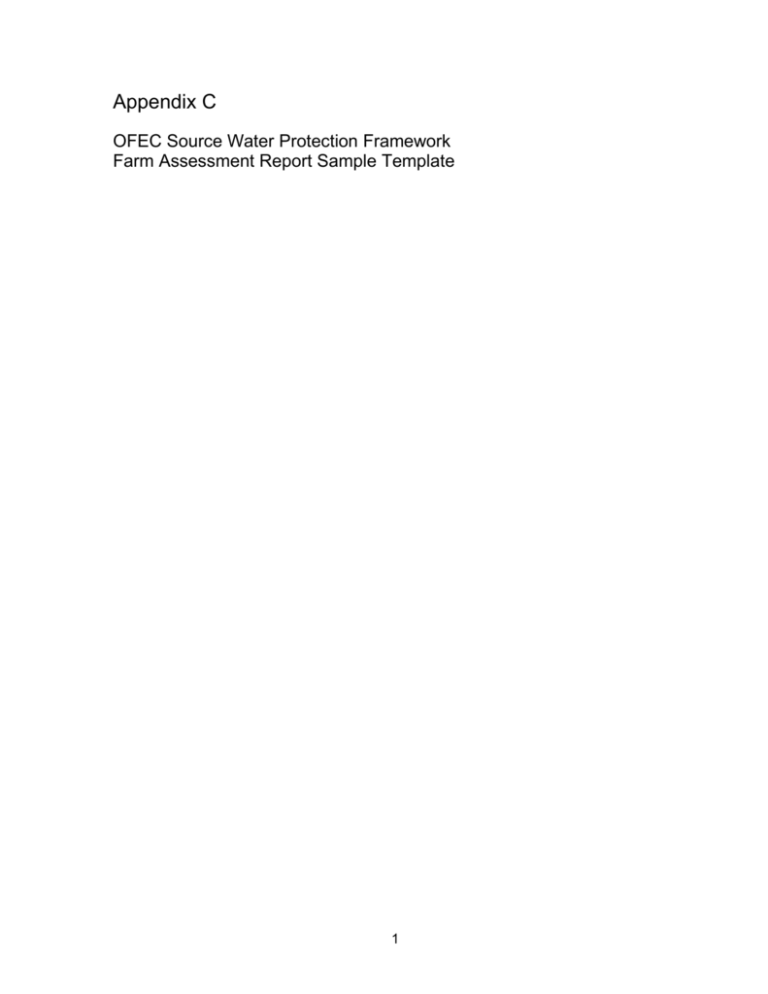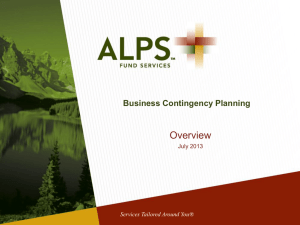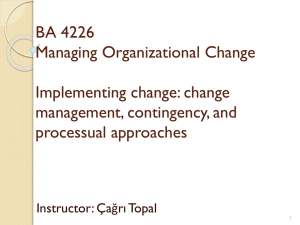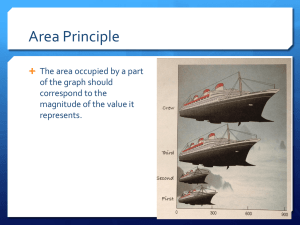Farm Assessment Report Sample Template
advertisement

Appendix C OFEC Source Water Protection Framework Farm Assessment Report Sample Template 1 The OFEC Source Water Protection Framework - Farm Assessment Report should include the following information: 1. Farm Operation Information Table 2. Overview of the Operation add details of owner and operator names and type and size of operation location of subject land and name of town and municipal well(s) affecting the property identify the applicable source protection plan (online) estimate the number of tillable acres in the source water WHPA/IPZ zone where a farming activity has been classified as a significant drinking water threat identify agricultural threats that are relevant to the operation and any prohibitions of farming practices written in the source protection plan that may be applicable explain farming practices that may not be applicable based on the provincial table of circumstances and more specifically the local source protection plan (e.g. pesticide application area too small) indicate if there is an approved instrument (NMS, NASM plan) that may exempt certain practices from being addressed in a risk management plan identify sensitive features on the subject property (wells, surface water, etc.) include any landowner or operator concerns (generation of headlands, yield loss, restrictions on building, compensation, etc.) 3. Farm Source Water Protection Assessment Table 4. Description of Threats (optional information to support assessment) for each relevant agricultural threat, identify if they are in a WHPA area with a vulnerability score of 10 or an IPZ area with a vulnerability score of 8 or greater. It is in these areas that the agricultural threat is considered a significant risk to water quality under the Clean Water Act process identify which farm properties (if multiple) are to be considered for this threat for each threat barrier (containment, spatial, or contingency), describe the specific standard or practice that is currently being applied to the agricultural threat of concern so it can be evaluated against the management levels (1, 2 or 3) as described in the OFEC Framework booklet. Provide enough detail of the activity for third party review (e.g. nutrient and pesticide application timing and method, storage type, livestock yard size, OCA size and construction date, etc.) Repeat for ALL applicable threats 5. Map Information - Farm Unit Map include mapping information to help describe the farm site and its associated area of source water vulnerability identify all farm properties considered a source water threat on one map if possible 2 the following list of information is valuable to include and present in a mapped format: Farm site map title Property name(s) and property boundaries Lot and concession Closest town and direction of that town Surrounding roads Municipal well location(s) or direction of municipal well(s) of concern North arrow Scale Legend Information sources could include Agricultural Information Atlas, County or Conservation Area interactive web-based GIS portal, Source Protection Area website mapping 6. Map Information - Field or Farmstead Maps include mapping information to help describe the farm site and its associated area of source water vulnerability identify all farms and fields on a map with the WHPA/IPZ areas and vulnerability scores indicated if the vulnerability mapping is available include a farmstead map if applicable only when it is in a significant source water vulnerability area features to include on the map: Farm site map title Property name(s) and property boundaries Lot and concession Closest town and direction of that town Surrounding roads Municipal well location(s) or direction of closest municipal well(s) of concern Identification of any significant vulnerability areas and WHPA/IPZs Number of tillable acres in each significant vulnerability area Sensitive features if in significant area (wells on property and neighbouring properties, surface water, etc.) Setback distances from sensitive features if in significant area Runoff management (storage, vegetated flow path, filter strip, etc.) Presence of field tile or tile inlets Buildings, permanent or temporary nutrient storages, fuel tanks, etc. if in significant area North arrow Scale Legend Information sources could include Agricultural Information Atlas, County or Conservation Area interactive web-based GIS portal, Source Protection Area website mapping 3 **Please note: The OFEC Farm Assessment Report should NOT include recommendations to the farmer, or list chemicals that are not listed as pesticides in the OFEC Framework booklet worksheets. These can be provided separately to the landowner if requested. 4 Farm Operation Information Table Consultant Meeting Date: Attendees: Certified Consultant: Risk Management Officer Name: Contact Information Owner/Operator Name: Street Address: City/Town/Village: Postal Code: Home Phone: Cell Phone: Fax: Email: Farm Information Farm Operation Name: Operation Type: Livestock Type (number): Tillable Acreage: Upper Tier Municipality: Lower Tier Municipality: Geotownship: Environmental Farm Plan Peer Reviewed: Environmental Farm Plan Completed: Nutrient Management Strategy Approved: Nutrient Management Plan Completed: Subject Land Information Owned/Rented: Lower Tier Municipality: Geotownship: Concession: Lot: Roll Number: Source Protection Area: Local Source Water Protection Plan: Approx. acres in WHPA vulnerability zone: score 10__________ 8 to <10__________ Approx. acres in IPZ vulnerability zone: score 10__________ 9 to <10__________ 8 to <9__________ 5 Source Water Protection Farm Assessment Table For each farm site being assessed in a WHPA area with a vulnerability score of 10 or IPZ area with a vulnerability score of 8 or greater, indicate the Level of Standard or Practice for each applicable Threat by entering ‘X’ in the most appropriate column. Refer to the OFEC Framework booklet, as well as the local source protection plan and Provincial table of circumstances for more detailed information. http://www.ene.gov.on.ca/environment/en/legislation/clean_water_act/STDPROD_081301.html. Well Head Protection Area (WHPA) Table of Threats Threat No. Threat Description Barrier Containment 3 Application of Agricultural Source Material in WHPA Spatial Contingency Containment 4 Storage of Agricultural Source Material in WHPA Spatial Contingency 5 Management (Handling) of Agricultural Source Material in WHPA Containment Standard or Practice Nutrient Management Plan Calibrate & Maintain Equipment Cover Crop Use in Fall if ASM is Applied Application Rates of Nitrogen Application Setback Distance to Private Drilled Well (with a watertight casing extending at least 6m below grade) Application Distance to Any Other Type of Private Well Supervision of Tank Filling Contingency Plan Training of Farm Personnel Design Criteria for Manure Storage Facilities (Liquid and Solid) Distance to Drilled Well (with a watertight casing extending at least 6m below grade) Distance to Any Other Type of Private Well Distance Between Storage Floor and Bedrock or Uppermost Aquifer Contingency Plan Training of Farm Personnel Storage Capacity Volume and Nutrient Reduction of ASM Transfer System Clean Water Control 6 Level 1 Level 2 Level 3 NA Spatial Contingency Containment 6 Application of Category 1 NonAgricultural Source Material in WHPA Spatial Contingency Containment 7 Storage of Category 1 NonAgricultural Source Material in WHPA Spatial Contingency Containment 8 Application of Commercial Fertilizer in WHPA Spatial Contingency Distance to Drilled Well (with a watertight casing extending at least 6m below grade) Distance to Any Other Type of Private Well Supervision of Transfer Contingency Plan Training of Farm Personnel Material Application Rate (Liquid or Solid) Materials Application Practices at Time of Application Winter Spreading Application Setback Distance to Private Drilled Well (with a watertight casing extending at least 6m below grade) Distance to Any Other Type of Private Well Supervision of Transfers Contingency Plan Training of Farm Personnel Design Criteria for Permanent Category 1 NASM Storage Facilities Distance to Drilled Private Well (with a watertight casing extending at least 6m below grade) Distance to Any Other Type of Private Well Distance Between Storage’s Concrete Floor and Bedrock or Uppermost Aquifer Contingency Plan Training of Farm Personnel Nutrient Management Plan Calibrate and Maintain Equipment Cover Crop Use in Fall if Commercial Nitrogen Fertilizer is Applied Application rates of Nitrogen Application Setback Distance to Any Type of Private Well Vegetated Buffering of any Type of Private Well Supervision of Tank Filling Contingency Plan Training of Farm Personnel 7 Dry Storage Containment 9 Handling and Storage of Commercial Fertilizer in WHPA Spatial Contingency Dry Handling Liquid Secondary Containment Liquid Handling Rinsate Disposal Distance to Private Drilled Well (with a watertight casing extending at least 6m below grade) Distance to Any Other Type of Private Well Inspection of Liquid Fertilizer Storage While in Use Anti-Backflow or Air Gap for Mixing and Loading (liquids only) Contingency Plan Training of Farm Personnel Containment 10 Application of Pesticide in WHPA Spatial Contingency Pest Control Practices Calibrate and Maintain Equipment Pesticide Training Application Setback Distance to Drilled Private Well (with a watertight casing extending at least 6m below grade) Distance to Any Other Type of Private Well Supervision of Tank Filling Contingency Plan Training of Farm Personnel Containment 11 Handling and Storage of Pesticide in WHPA Spatial Contingency 15A Handling and Storage of Heating Fuel Containment Storage Type and Area Liquid Secondary Containment Rinsate Disposal Distance Drilled Private Well (with a watertight casing extending at least 6m below grade) Distance to Any Other Type of Private Well Supervision of Tank Filling Contingency Plan Anti-Backflow or Air Gap for Mixing and Loading Training of Farm Personnel Storage Tank Construction and Integrity Secondary Containment 8 (Fuel Oil) in WHPA Spatial Contingency Containment 15B Handling and Storage of Motor Fuel (Liquid Fuels – Gasoline and Diesel) in WHPA Spatial Contingency 21A Outdoor Confinement Areas & Livestock Yards in WHPA (>1 NU/ac/year) Spatial Contingency Distance to Drilled Well (with a watertight casing extending at least 6m below grade) Distance to Any Other Type of Private Well Vehicle Protection (where applicable) Inspection Inspection of Connection to Appliance Contingency Plan Overfill Protection Storage Tank Construction and Integrity Secondary Containment Distance to Drilled Well (with a watertight casing extending at least 6m below grade) Distance to Any Other Type of Private Well Vehicle Protection (where applicable) Inspection Supervision of All Vehicle Tank Filling Contingency Plan Runoff Management from OCA or Livestock Yard Facilities Distance to Drilled Private Well (with a watertight casing extending at least 6m below grade) Distance to Any Other Type of Private well Yard Cleaning/Sanitation Contingency Plan Training of Farm Personnel Containment 21B Grazing or Pasturing in WHPA (1 NU/acre/year or less) Spatial Contingency Nutrient Management Private Wellhead Protection for all Types of Wells within 30m of Grazing and Pasturing Depth to Bedrock or Watertable when site’s vulnerability score = 10 General Inspection of Pasture Areas Contingency Plan Training of Farm Personnel 9 Intake Protection Zone (IPZ) Table of Threats Threat No. Threat Description Barrier Containment 3 Application of Agricultural Source Material in IPZ Spatial Contingency Standard or Practice Nutrient Management Plan Calibrate and Maintain Equipment Buffer Alongside Surface Water Cover Crop Use in Fall if ASM is Applied Application Rates of N and P Application Setback Distance to Surface Water Field Drainage Tile monitoring – Liquid ASM Supervision of Tank Filling Contingency Plan 4 Storage of Agricultural Source Material in IPZ Containment Spatial Contingency Containment 5 Management (Handling) of Agricultural Source Material in IPZ Training of Farm Personnel Design Criteria for Manure Storage Facilities (Liquid and Solid) Distance to Surface Water Contingency Plan Training of Farm Personnel Storage Capacity Volume and Nutrient Reduction of ASM Transfer System Clean Water Control Spatial Contingency Distance to Surface Water Straight Line Distance to Field Drainage Tile Supervision of Transfer Contingency Plan Training of Farm Personnel 6 Application of Category 1 NonAgricultural Source Material in IPZ Containment Spatial Contingency Material Application Rate Buffer Alongside Surface Water Winter Spreading Materials Application Practices at Time of Application Application Setback Distance to Nearest Surface Water Field Drainage Tile Monitoring – Liquid NASM 10 Level 1 Level 2 Level 3 NA Supervision of Transfers Contingency Plan Containment 7 Storage of Category 1 NonAgricultural Source Material in IPZ Spatial Contingency Containment 8 Application of Commercial Fertilizer in IPZ Spatial Contingency Training of Farm Personnel Design Criteria for Permanent Category 1 NASM Storage Facilities Separation Distance from any Private Well Distance to Surface Water Straight-Line Distance to Field Drainage Tile Contingency Plan Training of Farm Personnel Nutrient Management Plan Calibrate and Maintain Equipment. Buffer Alongside Surface Water Cover Crop Use in Fall if Commercial Fertilizer is Applied Application Rates of N and P Application Setback Distance to Surface Water Supervision of Tank Filling Contingency Plan Training of Farm Personnel Dry Storage Containment 9 Handling and Storage of Commercial Fertilizer in IPZ Dry Handling Liquid Secondary Containment Liquid Handling Rinsate Disposal Spatial Contingency Distance to Surface Water Inspection of Liquid Fertilizer Storage While in Use Anti-Backflow or Air Gap for Mixing and Loading (liquids only) Contingency Plan Training of Farm Personnel 10 Application of Pesticide in IPZ Containment Spatial Contingency Pest Control Practices Calibrate and Maintain Equipment Pesticide Training Application Setback Distance to Surface Water Supervision of Tank Filling 11 Contingency Plan Training of Farm Personnel Containment 11 Handling and Storage of Pesticide in IPZ Spatial Containment 15A Spatial Contingency Containment 15B Handling and Storage of Motor Fuel (Liquid Fuels – Gasoline and Diesel) in IPZ Spatial Contingency Containment 21A Outdoor Confinement Areas & Livestock Yards in IPZ (>1 NU/ac/year) Distance to Surface Water Supervision of all Tank Filling Contingency Handling and Storage of Heating Fuel (Fuel Oils) in IPZ Storage Type and Area Liquid Secondary Containment Rinsate Disposal Spatial Contingency Plan Anti-Backflow or Air Gap for Mixing and Loading Training of Farm Personnel Storage Tank Construction and Integrity Secondary Containment Distance to Surface Water Vehicular Protection (where applicable) Inspection Inspection of Connection to Appliance Contingency Plan Overfill Protection Storage Tank Construction and Integrity Secondary Containment Distance to Surface Water Inspection Supervision of all Vehicle Tank Filling Contingency Plan Vehicle Protection (where applicable) Runoff Management from OCA or Livestock Yard Facilities Permanently Vegetated Flow Path to Surface Water – when dry matter produced by livestock in yard ranges from 30% to 50% (see Nutrient Management Regulation Tables) (All dry matter contents for OCA) Permanently Vegetated Flowpath to Surface Water – when dry matter of manure produced by livestock in yard is > 50% (see Nutrient 12 Management Regulation Tables) Straight-Line Distance to Field Drainage Tile Yard Cleaning/Sanitation Contingency Contingency plan Training of Farm Personnel Containment 21B Grazing or Pasturing in IPZ (1 NU/acre/year or less) Spatial Contingency Nutrient Management Buffer Alongside Surface Water Livestock Access to Surface Water General Inspection of Pasture Areas Contingency Plan Training of Farm Personnel The details of this OFEC Farm Assessment Report include the current farming practices on the identified land. Planned activities and practices are subject to change from year to year as farming is a dynamic industry and external factors can result in last minute management changes (weather, crop prices, product availability etc). If the farming practices change drastically from this overview at anytime, an update will need to be completed. ____________________ Signature Farm Assessment Contact __________________ Date 13






